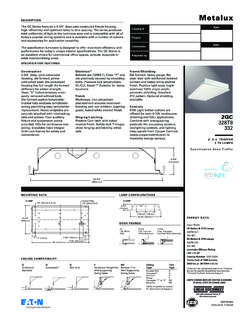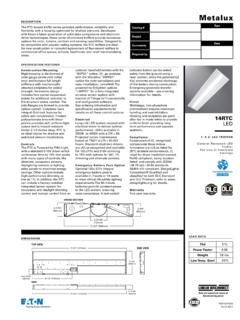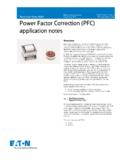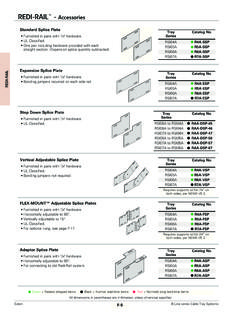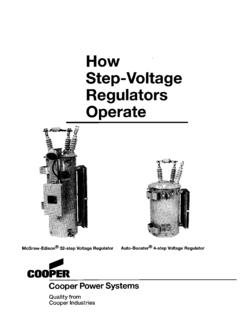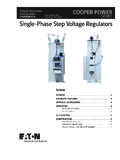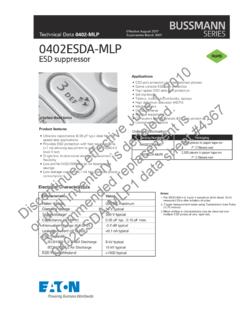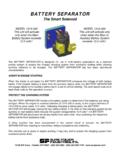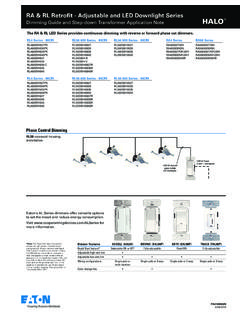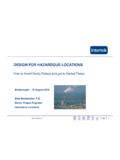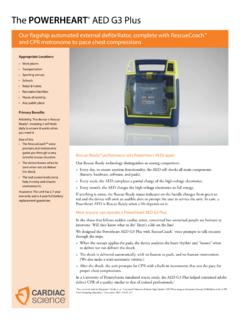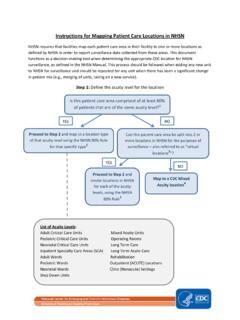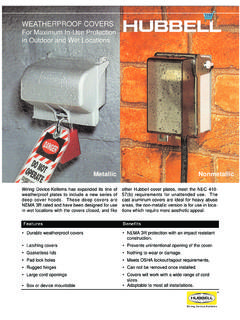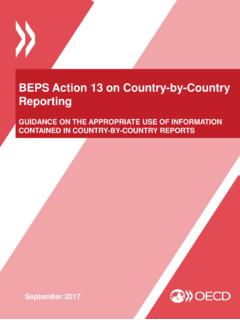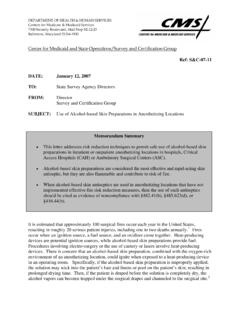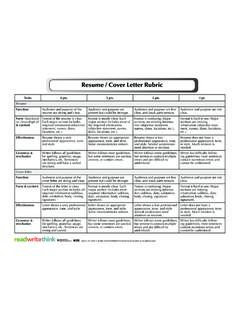Transcription of Fuses for Hazardous Locations # 3186 - Cooper Industries
1 224 2014 EatonFuses for Hazardous LocationsHazardous LocationsFuses for Use in Classified ( Hazardous ) Locations (based upon the NEC ) The characteristics of various atmospheric mixtures of Hazardous gases, vaporsand dusts depend on the specific Hazardous material involved. Therefore, it is necessary that equipment be identified not only for the class of location but also forthe specific gas, vapor or dust that will be present ( ).Class I Division 1 Fuses located in Class 1 Division 1 Locations are required to be provided withenclosures that are identified as a complete assembly for use in Class I Locations [ (A)].
2 Class I Division 2 Fuses located in Class I Division 2 Locations should be selected based upon theapplication and enclosure type. Only certain fuse types are permitted to be used ingeneral purpose enclosures. (B)(5), (B)(3) & (B)(4)address the use of Fuses in Class I Division 2 Locations . (See Figure 1) Any plug or cartridge type fuse , as allowed by Chapters 1 through 4 of the NEC ,is suitable for the protection of motors, appliances, and lamps, provided the fuseis installed in an enclosure identifiedfor the location.
3 Fuses for the protection of motors, appliances, and lamps installed in general purpose enclosures must also meet one of the following:a) They are non-indicating, filled and current-limiting type. Bussmann offersmany Fuses that meet the criteria for non-indicating, filled, current-limitingtype (See Note 1 and Note 2)b) They are the type in which the element is immersed in oil or other approvedliquid. Bussmann does not offer this type of ) The element is hermetically sealed against gases and vapors. Bussmanndoes not offer hermetically sealed Fuses for this type of application.
4 Fuses protecting meters, instruments and relays can be any plug or cartridge typeif they meet the following criteria:a) fuse is installed in a circuit not subject to overloadingb) fuse is installed on the load side of a switch complying with (B)(1) Fuses installed in a luminaire and used as supplementary protection can be anylisted cartridge there are so many potential variables governing the proper selection of afuse for use in general purpose enclosures, the quickest and most appropriateselection is a current-limiting, non-indicating, filled fuse .
5 This fuse type is suitablefor all applications mentioned above so the chance for misapplication is addition, a rejection style fuse will help ensure only the proper fuse type isinstalled in the future. For 30A and less power or control applications theBussmann Class CC Fuses meet the necessary criteria. (See Note 1)Class II and Class IIIC lass II, Division 1 Fuses must be provided with enclosures identified for thelocation [ (A)].Class II, Division 2 Fuses must be provided with enclosures that are dust-tightor otherwise identified for the location [ (B) and (B)(3)].
6 Class III Fuses must be provided with dust-tight enclosures [ ]. Figure 1 NEC Article 501 Fuses for use in Class I Division 2 LocationsLP-CC KTK-R FNQ-RClass CC: LP-CC 1 2 - 30A, KTK-R 1 2 - 30 A, FNQ-R 8 10 - 30A*Class CF: Class CF: TCF1RN to TCF100RN, FCF1RN to FCF100 RNClass T:JJN 1 - 1200A, JJS 1 - 800 AClass J: JKS 1 - 600A, LPJ_SP 1 - 600 AClass G: SC 1 2 - 60 AClass RK1: KTN-R 1 - 600A, KTS-R 1 - 600A, LPN-RK_SP* 31 2 -61 4 and 70 -600A, LPS-RK_SP* 65 - 600 AClass RK5: FRN-R 31 2 - 71 2 and 225 - 600A, FRS-R** 65 - 600 AClass L.
7 KRP-C_SP 601 - 6000A, KTU 601 - 6000A, KLU 601 - 4000A* Fuses from July 1996 or date code C28 to present only.** Fuses from October 1997 or date code D40 to present onlyNote 1: Bussmann non-indicating, filled, current-limiting 2: How to verify a fuse as current-limiting. 600V or less current-limiting fusesare listed, and marked current-limiting .Is fuse protecting amotor, appliance, orlamp and installed inenclosure rated for theclassified location?( (B)(3))Is fuse installed in ameter, instrument, orrelay circuit where not subject to overloading?
8 ( (B)(5))Is fuse installed in aluminaire used as supplementary protection?( (B)(4))Is fuse installed onload side of switchcomplying (B)(1)?( (B)(5))Any plug orcartridge fuseOKAny plug orcartridge fuseOKFuses may be any listedcartridge fuseFuses* must be (1) non-indicating, filled,current-limiting type, or (2) have operating element immersed inoil or other approved liquid, or (3) be hermetically sealed.( (B)(3))NOYESYESYESYESNONONO*For the protection of motors, appliances, and lamps installed in general purposeenclosures.
